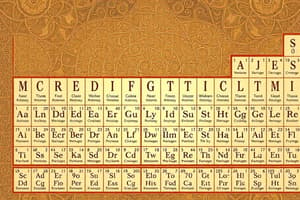Podcast
Questions and Answers
What is the significance of Dmitri Mendeleev and Julius Lothar Meyer's contributions to the periodic table?
What is the significance of Dmitri Mendeleev and Julius Lothar Meyer's contributions to the periodic table?
- They discovered hydrogen and helium.
- They disproved Moseley's atomic theory.
- They invented the concept of atomic number.
- They identified the periodic patterns of elements' properties. (correct)
How did Moseley's discovery in 1913 change the understanding of the periodic table?
How did Moseley's discovery in 1913 change the understanding of the periodic table?
- He established that periodicity depends on atomic numbers. (correct)
- He introduced a new element named after himself.
- He confirmed Mendeleev's organization based on atomic weights.
- He proved the periodicity of elements is based on atomic masses.
What did Mendeleev and Meyer do to account for undiscovered elements in their periodic tables?
What did Mendeleev and Meyer do to account for undiscovered elements in their periodic tables?
- Combine elements to fill in missing spots.
- Leave gaps in their tables. (correct)
- Exclude unknown elements from the table.
- Introduce a new classification system.
How many elements are present in the first period of the periodic table?
How many elements are present in the first period of the periodic table?
What is the basis for dividing the periodic table into periods?
What is the basis for dividing the periodic table into periods?
Why was Moseley's discovery regarding the organization of the periodic table important?
Why was Moseley's discovery regarding the organization of the periodic table important?
How many elements are in the second and third periods of the periodic table?
How many elements are in the second and third periods of the periodic table?
What is unique about the fourth and fifth periods?
What is unique about the fourth and fifth periods?
Why was Mendeleev's original arrangement challenged by the transition metals?
Why was Mendeleev's original arrangement challenged by the transition metals?
Why do transition metals exhibit unique and valuable properties?
Why do transition metals exhibit unique and valuable properties?
Despite changes brought by modern physics, what has remained constant about the periodic table?
Despite changes brought by modern physics, what has remained constant about the periodic table?
How has the periodic table adapted to our evolving understanding of the universe?
How has the periodic table adapted to our evolving understanding of the universe?
Flashcards are hidden until you start studying
Study Notes
The Modern Periodic Table: Exploring Periods
The periodic table, a cornerstone of chemistry, has evolved over centuries to systematize our understanding of the elements. This iconic tool, a representation of the elements' atomic properties and chemical behaviors, has consistently proven indispensable to our progress in chemistry and our broader scientific understanding.
The Roots of the Periodic Table: Mendeleev and Meyer
In 1869, Dmitri Mendeleev and Julius Lothar Meyer, independently, identified the periodic patterns of the elements' properties. Mendeleev organized elements according to their atomic weights, while Meyer focused on their atomic masses. Both scientists left gaps in their tables to accommodate undiscovered elements, thus predicting their existence before they were found.
The Periodic Principle: Atomic Number and Periods
The periodic table's foundation was redefined in 1913 by Henry G. J. Moseley, who discovered that the periodicity of the elements was based on their atomic numbers rather than their atomic masses. This breakthrough allowed chemists to accurately determine the position of each element within the table and prevent confusion created by variations in atomic mass.
The Organization of Periods
The periodic table is divided into periods, columns of elements with increasing atomic numbers. The first period contains only two elements: hydrogen and helium. The second and third periods each contain eight elements, while the fourth and fifth periods contain 18 elements each. Later periods have so many elements that they are split into segments, with one segment beneath the main body of the table.
The Transition Metals and Periods
The central portion of the periodic table, the transition metals, presented a challenge to Mendeleev's original arrangement. The transition metals' properties and atomic weights did not align with the trends seen in the rest of the table. However, modern understanding of the periodic table now reveals that the transition metals' electronic structure and their partial filling of inner electron shells produce their unique and valuable properties.
The Future of the Periodic Table
The periodic table remains an unparalleled scientific tool in its ability to predict, classify, and understand the elements and their properties. Despite the profound changes brought by modern physics, the periodic table's fundamental structure has not been overthrown, but rather it has adapted and grown with our evolving understanding of the universe.
Studying That Suits You
Use AI to generate personalized quizzes and flashcards to suit your learning preferences.




